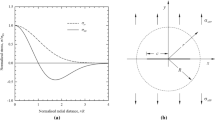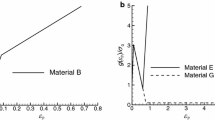Abtract
The problem of initiation of crack growth in an elastic-plastic material under idealized conditions of plane stress or plane strain was studied. The stress analysis of the cracked plate was performed by using an elastic-plastic finite element computer program based on the J 2 flow theory of plasticity and a singular crack tip element. A method for determining the critical quantities at the moment of crack growth was presented. The strain energy density failure criterion was used according to which the crack starts to grow when material elements ahead of the crack absorb a critical amount of stored strain energy density which remains after subtracting the amount of irreversible energy dissipated by permanent deformation. The critical stress and the plastic zone at crack initiation were determined. No restrictions regarding the amount of plastic deformation at the crack tip and the form of the stress-strain diagram of the material in tension were imposed in the analysis. Results were given for a center cracked plate specimen for various crack lengths and ultimate stresses of the material in tension. The dependence of the critical stress on these factors and on the idealized conditions of plane stress or plane strain was established.
Résumé
On a étudié le problème de l'amorçage d'une fissure dans un matériau élastoplastique sous des conditions idéales d'état plan de tension ou d'état plan de déformation.
L'analyse des contraintes d'une plaque fissurée a été effectuée à l'aide d'un programme de calcul élasto-plastique par éléments finis basé sur une théorie de l'écoulement plastique. On présente une méthode pour déterminer les paramètres critiques au moment de la croissance d'une fissure. On utilise comme critère de rupture la densité d'énergie de déformation. Selon ce critère, la fissure démarre lorsque le volume de matière en avant de celle-ci absorbe une quantité de densité d'énergie de déformation accumulée, sous déduction de la quantité d'énergie irréversiblement dissipée par la déformation permanente. On détermine la contrainte critique et la zone plastique lors de l'amorçage de la fissure. Dans l'analyse, on n'a pas imposé de restriction sur l'étendue de la déformation plastique à l'extrémité de la fissure ou sur le forme du diagramme tension-dilatation de matériau en traction. Les résultats sont fournis dans le cas d'une éprouvette plate à fissure centrale, pour diverse longueurs de fissure et résistances à la rupture du matériau. On établit une dépendance entre la contrainte critique et ces divers facteurs, ainsi qu'avec les conditions idéalisées d'état plan de tension ou de déformation.
Similar content being viewed by others
References
Plane Strain Crack Toughness Testing of High Strength Metallic Materials, W.F. Brown, Jr. and J.E. Strawley, eds, ASTM STP 410, American Society for Testing and Materials, Philadelphia (1966).
J.Eftis and H.Liebowitz, Engineering Fracture Mechanics 7 (1975) 101–135.
J.Eftis, D.L.Jones and H.Liebowitz, Engineering Fracture Mechanics 7 (1975) 491–503.
G.C.Sih, Properties Related to Fracture Toughness, ASTM STP 605 (1975) 3–15.
G.C. Sih and B.V. Kiefer, Nonlinear and Dynamic Fracture Mechanics, N. Perrone and S.W. Atluri, eds, ASME AMD 35 (1979) 136–156.
G.C.Sih and E.Madenci, Engineering Fracture Mechanics 18 (1984) 1159–1171.
E.E.Gdoutos, Theoretical and Applied Fracture Mechanics 1 (1984) 139–144.
E.E.Gdoutos and G.C.Sih, Theoretical and Applied Fracture Mechanics 2 (1984) 91–103.
J. W.Hutchinson, Journal of the Mechanics and Physics of Solids 16 (1968) 13–31.
E.E. Gdoutos, Problems of Mixed Mode Crack Growth, Martinus Nijhoff Publ. (1984).
E.E. Gdoutos, in Proceedings International Conference on Application of Fracture Mechanics to Materials and Structures, Freiburg, Germany, 20–24 June 1983, G.C. Sih, E. Sommer and W. Dahl, eds, Martinus Nijhoff Publishers (1984) 237–249.
Author information
Authors and Affiliations
Rights and permissions
About this article
Cite this article
Gdoutos, E.E., Papakaliatakis, G. Crack growth initiation in elastic-plastic materials. Int J Fract 32, 143–156 (1986). https://doi.org/10.1007/BF00018349
Received:
Revised:
Issue Date:
DOI: https://doi.org/10.1007/BF00018349




